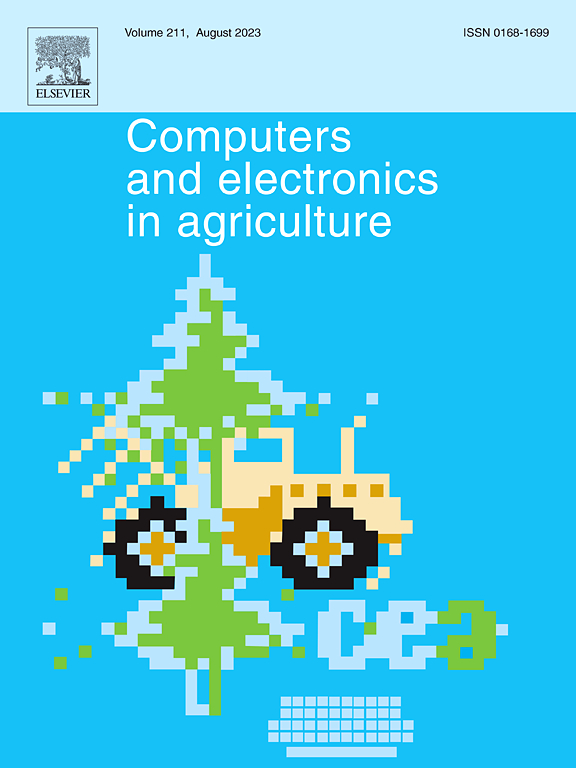DEPTHNAV: An autonomous navigation system using depth camera and deep learning in a commercial chicken farming house
IF 7.7
1区 农林科学
Q1 AGRICULTURE, MULTIDISCIPLINARY
引用次数: 0
Abstract
The increasing automation in commercial livestock farming has raised the demand for more advanced indoor robotic navigation systems. However, current technologies face limitations such as sensitivity to ambient light, inadequate navigation accuracy, and challenges in long-term reliability. In this study, a novel navigation system was proposed, DEPTHNAV (Depth Enhanced Poultry House Navigation), designed specifically for commercial stacked cage farming environments. DEPTHNAV utilizes a depth camera as its primary imaging sensor. By processing pseudo-color images derived from depth data using YOLOv8 (You Only Look Once), the system achieves accurate longitudinal positioning. On the upper floor, with a speed of 0.2m s−1, the standard deviation in longitudinal positioning was less than 1.36 m, while on the ground floor, at a speed below 0.3m s−1, it was under 1.83 m. Additionally, the chassis’ yaw angle was extracted by analyzing point cloud data, ensuring precise lateral control for straight-line movement within aisles. On the upper floor, at 0.2m s−1, the standard deviation of lateral deviation was under 2.21 m, and on the ground floor, it was below 1.80 m at a speed under 0.3m s−1. Its marker-free design simplifies implementation while offering high accuracy and adaptability, making it ideal for scalable applications in automated poultry farming.
deepthnav:在商业养鸡场使用深度相机和深度学习的自主导航系统
商业畜牧业自动化程度的提高提高了对更先进的室内机器人导航系统的需求。然而,目前的技术面临着诸如对环境光的敏感性、导航精度不足以及长期可靠性方面的挑战等限制。在本研究中,提出了一种新的导航系统,深度增强禽舍导航(Depth Enhanced Poultry House navigation),专门为商业堆叠笼养殖环境设计。deepthnav利用深度相机作为其主要成像传感器。通过使用YOLOv8 (You Only Look Once)处理深度数据衍生的伪彩色图像,系统实现了精确的纵向定位。上层在速度为0.2m s−1时,纵向定位标准差小于1.36×10-2 m,底层在速度小于0.3m s−1时,纵向定位标准差小于1.83×10-2 m。此外,通过分析点云数据提取底盘的偏航角,确保在通道内直线运动的精确横向控制。上层在0.2m s−1速度下,横向偏差标准差在2.21×10-2 m以下,底层在0.3m s−1速度下横向偏差标准差在1.80×10-2 m以下。其无标记设计简化了实施,同时提供高精度和适应性,使其成为自动化家禽养殖中可扩展应用的理想选择。
本文章由计算机程序翻译,如有差异,请以英文原文为准。
求助全文
约1分钟内获得全文
求助全文
来源期刊

Computers and Electronics in Agriculture
工程技术-计算机:跨学科应用
CiteScore
15.30
自引率
14.50%
发文量
800
审稿时长
62 days
期刊介绍:
Computers and Electronics in Agriculture provides international coverage of advancements in computer hardware, software, electronic instrumentation, and control systems applied to agricultural challenges. Encompassing agronomy, horticulture, forestry, aquaculture, and animal farming, the journal publishes original papers, reviews, and applications notes. It explores the use of computers and electronics in plant or animal agricultural production, covering topics like agricultural soils, water, pests, controlled environments, and waste. The scope extends to on-farm post-harvest operations and relevant technologies, including artificial intelligence, sensors, machine vision, robotics, networking, and simulation modeling. Its companion journal, Smart Agricultural Technology, continues the focus on smart applications in production agriculture.
 求助内容:
求助内容: 应助结果提醒方式:
应助结果提醒方式:


